The best analogy is bird song. The animal kingdom depends on mind to mind for ordinary communication and i expect to see that here. Yet for distance signalling, a bird song format works admirably. It all works well together.
In the meantime we have recordings of their music and that has taught us to respect the whale community by proving existence.
All very good.
Whale Song Explained
Humpbacks synchronize their music across oceans, and there’s sheet music to prove it.
Words by David Rothenberg
Images by Mike Deal
https://medium.com/@dealville/whales-synchronize-their-songs-across-oceans-and-theres-sheet-music-to-prove-it-b1667f603844
The largest single pressing of any album of recorded music was not made by Michael Jackson or Mariah Carey, but by an animal the size of a city bus. Ten million copies of Songs of the Humpback Whale were inserted into the January 1979 issue of National Geographic, distributed around the world in 25 languages. The humpback’s cries are credited with inspiring the global movement of conservation measures to protect whales. But what is often overlooked is the true musicality of the sounds. The shrill wails, deep growls, rhythmic scratches, and spectral moans combine into repeating patterns so structured that they fit any conventional definition of music.
There are eleven populations of humpbacks around the world, each covering their own ocean-sized territory. These populations each boast not only their own dialect of song, but also their own anthem of sorts — each whale singing the same sequence of the same sounds. But week-to-week, month-to-month, and year-to-year this song evolves, as the whales collectively create new phrases and patterns, totally in sync.
The uniqueness and creativity behind this animal’s music is hard to appreciate by listening to the sounds alone (let alone reading about it with words). Instead, we must turn to graphic representations of sound to visually emphasize the patterns — and bring them to life.
Cover image from Songs of the Humpback Whale LP, Capitol Records, 1970
It was in the 1950s during the height of the Cold War when the military built a network of underwater microphones to track the secret rumblings of Soviet submarines and sonar codes. But what sonar operators began to hear amid the man-made explosions were the songs of the whales, which can sometimes last for up to 23 hours. In 1968 one of those operators was authorized to turn his body of recordings over to budding whale scientist Roger Payne, assisted by researcher Scott McVay.
McVay and his mathematician wife Hella laid out primitive sonograms of fragments of the whale’s songs on their living room floor (sonograms graph the pitch and texture of a sound against time). Each ten seconds of song took about one hour to spew out from a thermal-paper sonogram-printing device, designed to break World War II codes and used in the 1960’s by speech therapists. Hella was the first to appreciate the structure through this visual representation. “Amazing!…it repeats!” she exclaimed.
Soon, Payne and McVay traced sonograms by hand to render the sounds without extraneous noise, echoes, or harmonics:
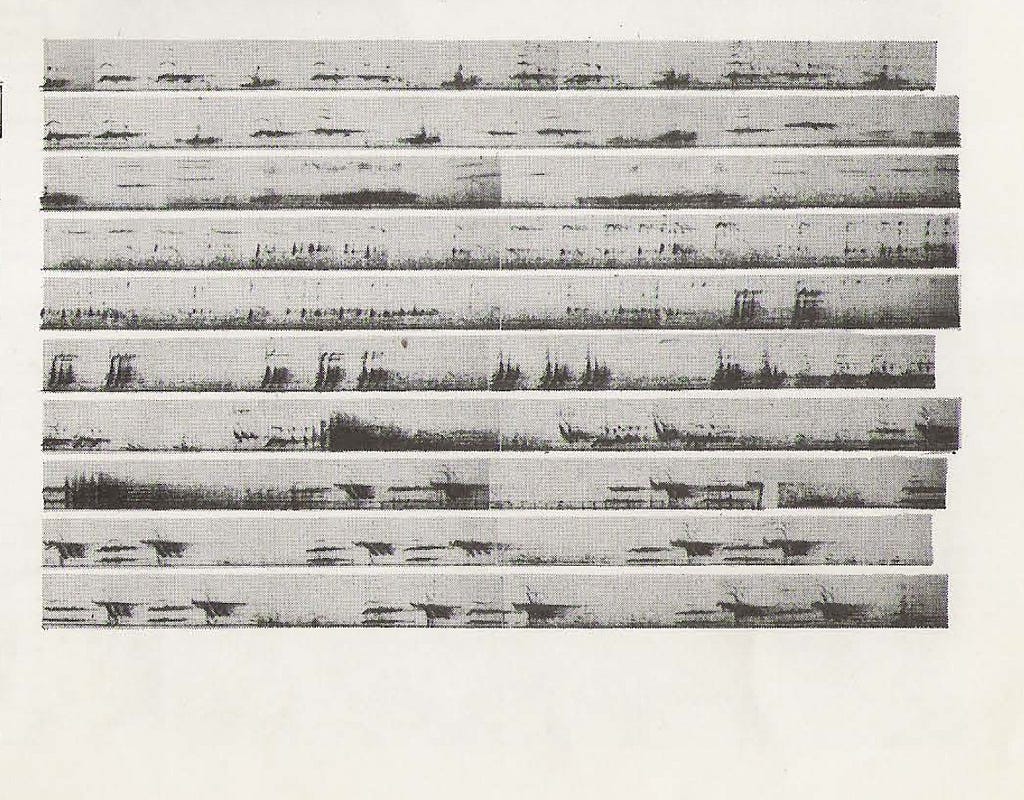
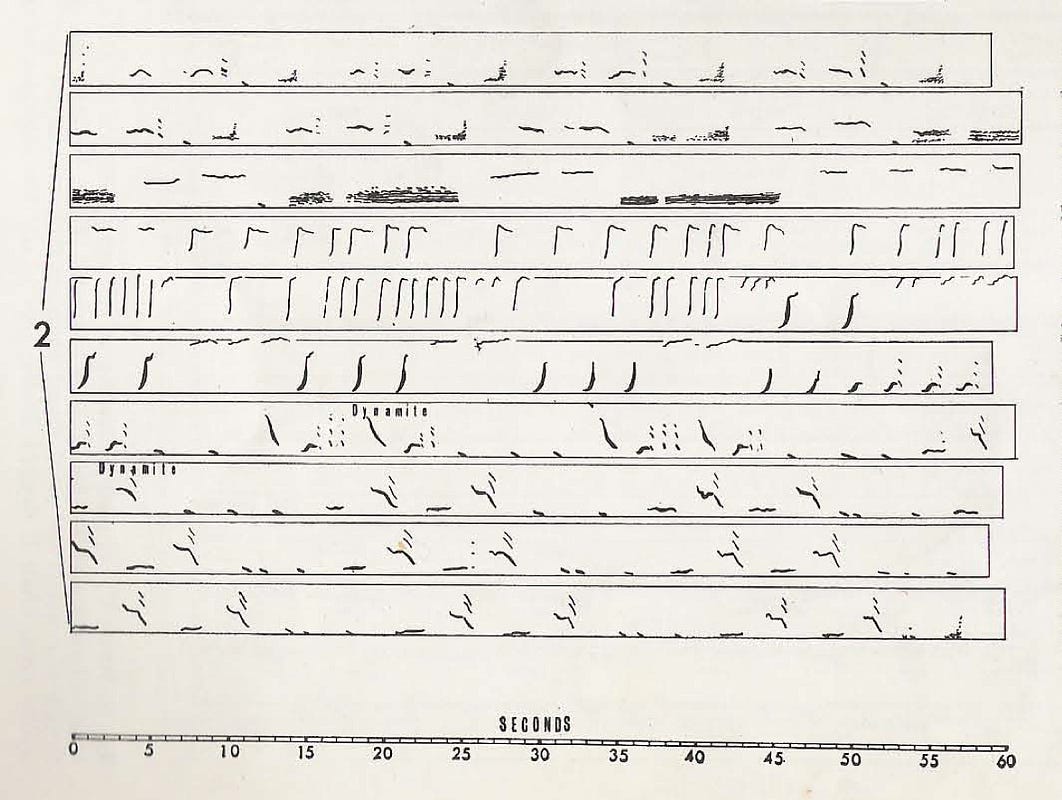
Then, to organize the patterns they found, they devised a hierarchical notation system:
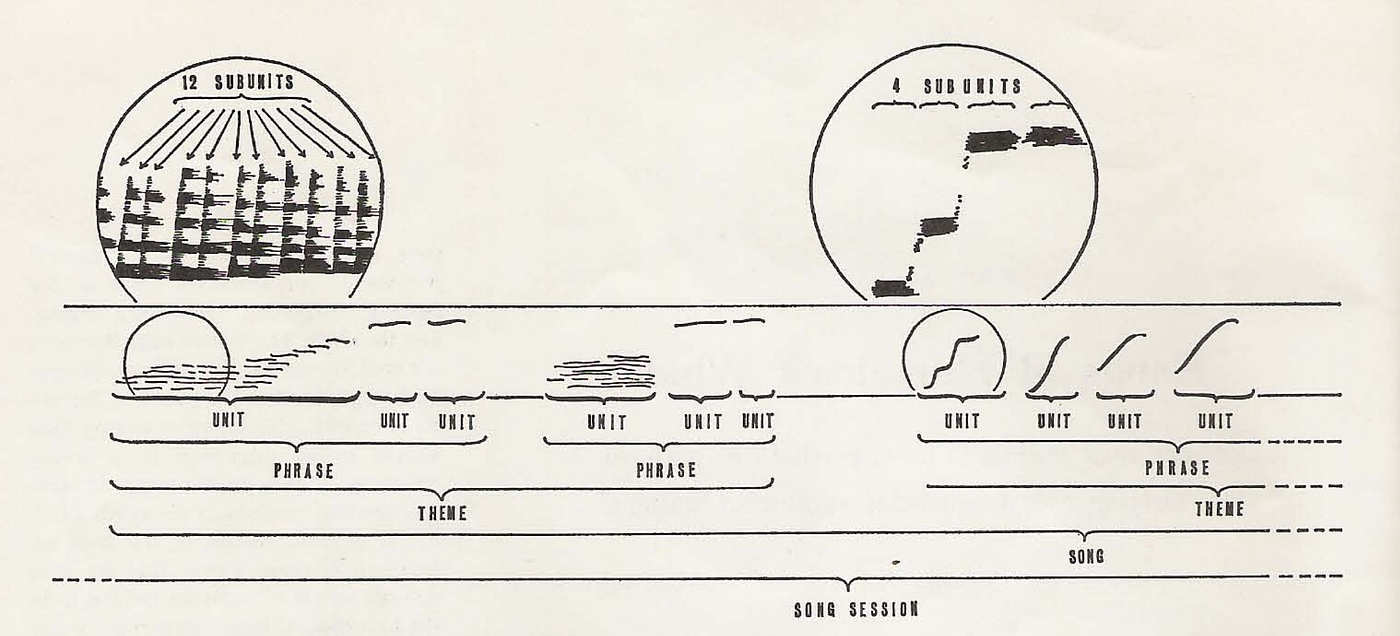
Unit: An individual vocalization, and the smallest building block of the song structure.
Phrase: The next level in the hierarchy, a repeating series of units, lasting 20–40 seconds
Theme: A sequence of phrases.
Song: A sequence of themes, typically spanning 5–30 minutes.
Song Session: A whale usually repeats a song many times, in sessions that can last a full day.
They had visual proof that these beasts were not making random sequences of moans, grunts, and clicks, but were instead creating organized underwater music. The story appeared on the cover of Science magazine in August 1971.

Whale songs include a strange range of sounds, from the bowed bass beats of a giant sub-surface fiddle to the feedback squelches of an electric guitar. But we have trouble perceiving the structure by which the sounds are organized because the notes seem cast out in slow motion, with relatively long silences between each unit of sound.
To better appreciate the patterns, we can speed a song up by ten times, allowing us to hear a compressed version that sounds like the song of a bird:
To help see the patterns, we can use color to denote matching units. Here’s the Science cover again, colored according to Payne and McVay’s classification of units:
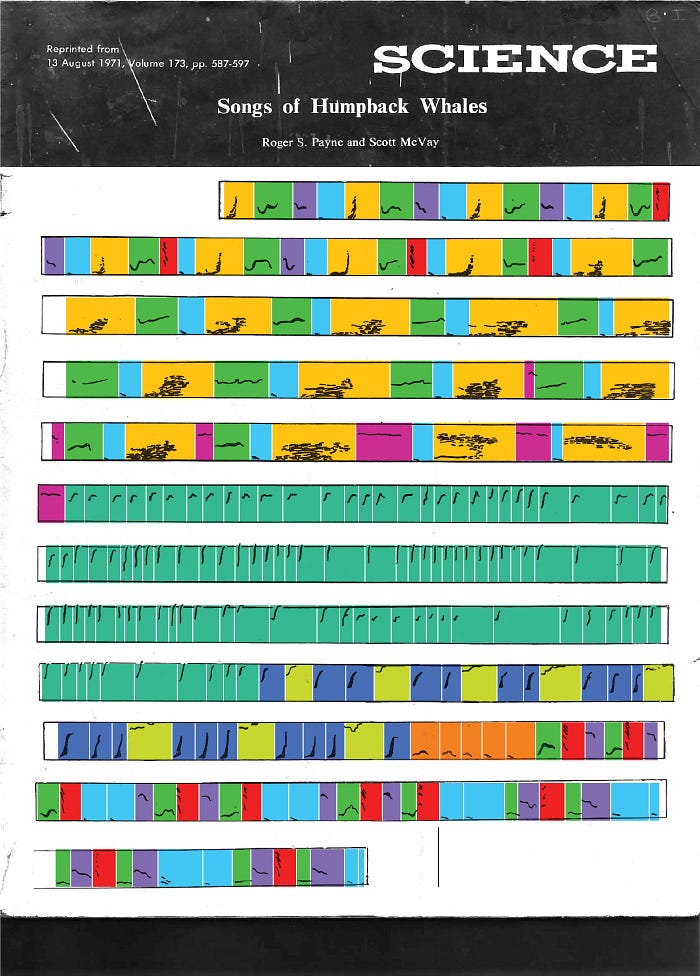
Different instances of the same unit can vary in length (the yellow units above gradually expand with each repetition), yet share enough sonic traits to be classified as a common unit.
The set of shapes resembles the notation of Gregorian chants written in the tenth century.

Neumatic musical notation from the
10th century

Musical notation becoming more precise from the 10th to 14th centuries
The fluid musical notes of the chants are called “neumes.” They did not represent exact pitches or rhythms, but tendencies of pattern, the same elements McVay and Payne identified in the songs of the whales.
As the tuning of instruments standardized, and music matured to move between one key and another, it became increasingly important that the pitches of notes be indicated more precisely. From the tenth to the fourteenth centuries the neumes evolved into the conventional musical notation we still use today.
Data visualization designer Mike Deal and I figured that if we followed a similar progression of standardization, we could further emphasize the structure of whale song. We created a graphic notation system, where each discrete sound unit in a given population’s shared song is assigned its own stylized shape and color.
Here are the nine units that make up a song recorded by Paul Knapp off the coast of Tortola:
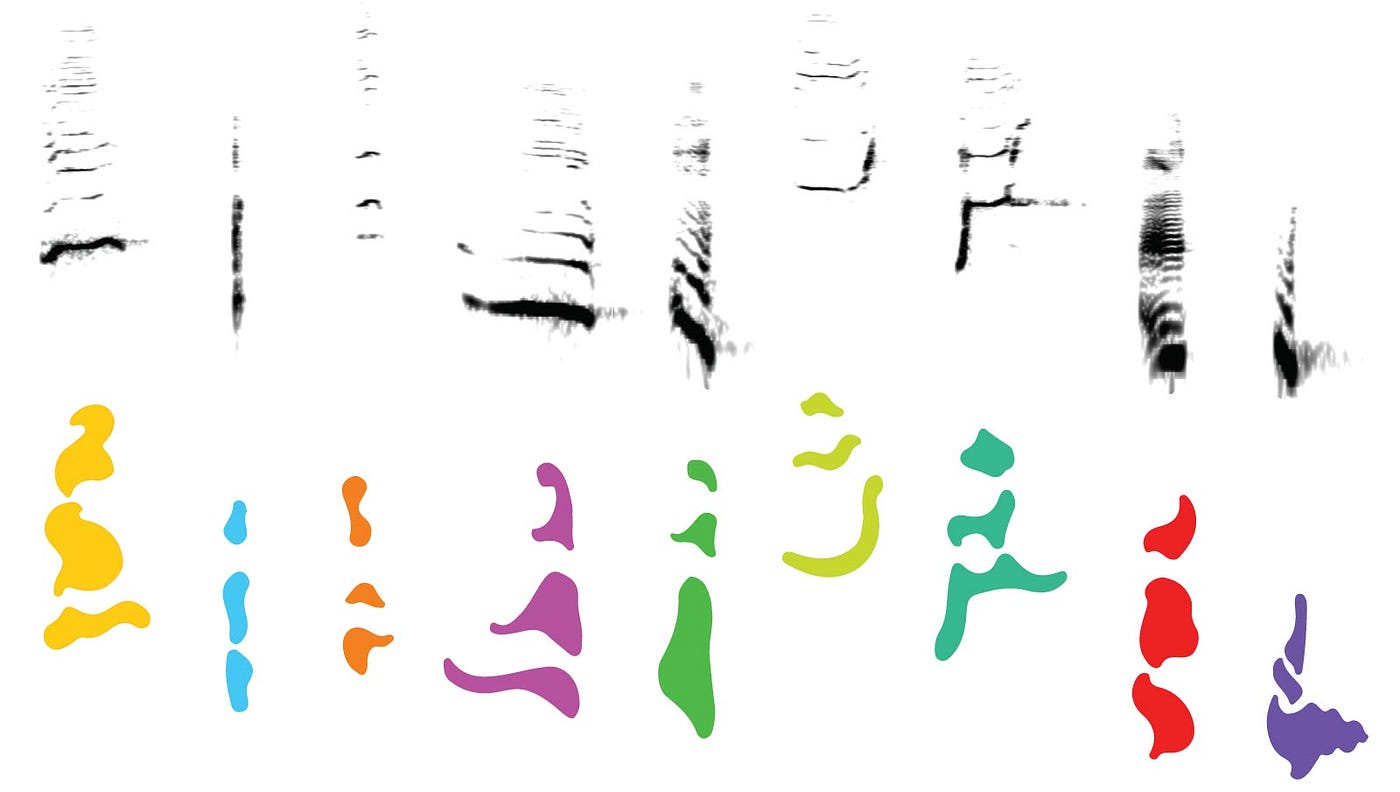
The top row contains individual examples of each unit. The colored glyphs below were created by tracing the “averaged” shapes that resulted from overlaying the many occurrences of the same unit across Knapp’s recording.
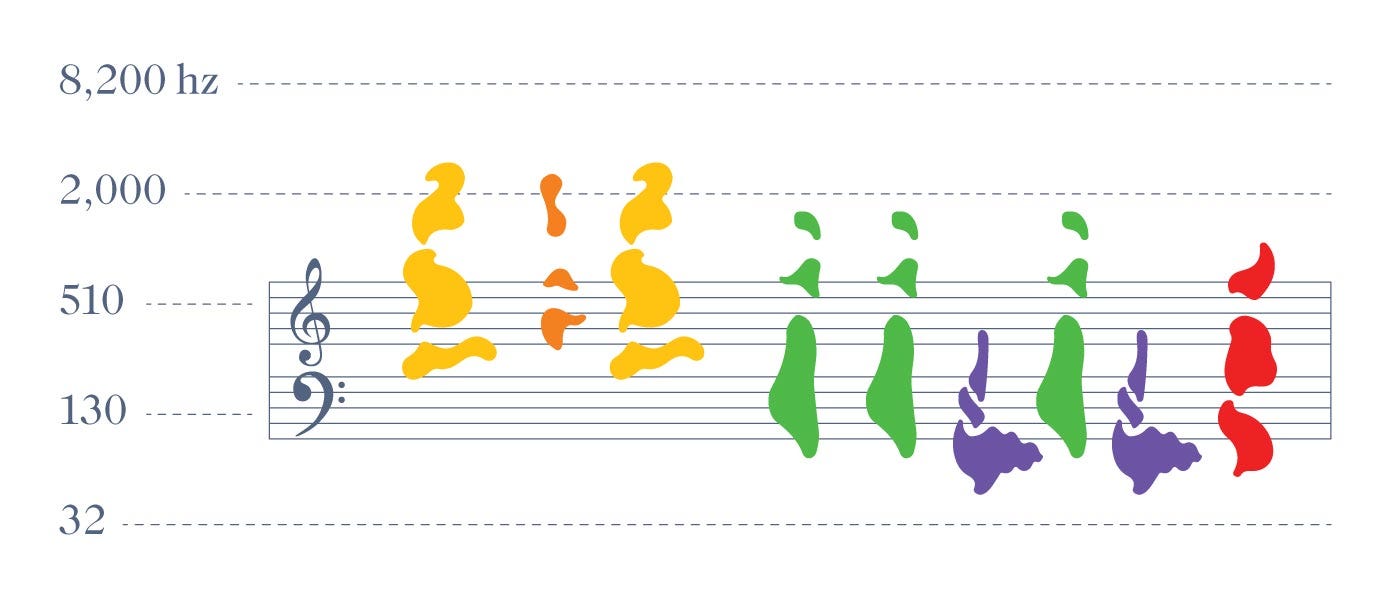
Each solid horizontal line in the staves of standard musical notation represents a different number of Hertz along a logarithmic frequency scale. These whale song sonograms share the same logarithmic scale, conveniently allowing us to combine the two visualization contexts.
Because standard musical notation is, in essence, made of timelines of note symbols plotted against a vertical axis of pitch frequencies, we can match the whale sounds to their corresponding frequencies on the musical staves. Hopefully this gives the whale sound shapes a more familiar context.
Here is Knapp’s entire recording mapped out. We see a five-themed song repeating three times in the same song session.
We can apply this approach to any song from the eleven different humpback populations. Here is a song I recorded off the coast of Maui:
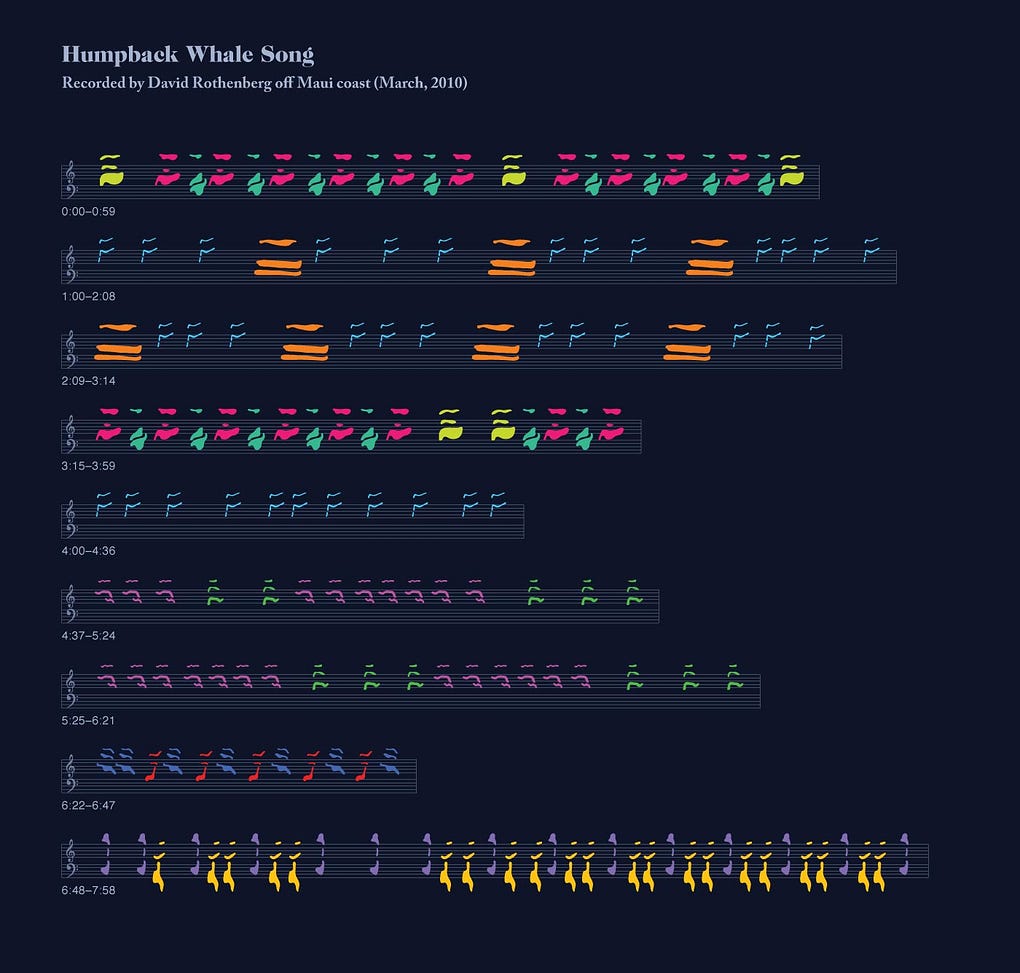
And here it is animated:
The pattern in the phrases starts to seem like an alien language. But even eerier is how much more human-like the order appears than most known animal vocal behaviors.
Communicating with symbols is rare among animals. A famous example is the honeybee, which represents complex information with its waggle dance, indicating where pollen can be found. Since only male whales sing — allowing scientists to assume the songs are sung to attract females — a whale’s song is closer to a bird’s song than a bee’s dance.
To illustrate courtship patterns to an extreme, bowerbirds in New Guinea not only sing, but also fashion sculptures out of twigs and leaves to attract the attentions of potential mates. The males of some species even spend hours a day painting their works with crushed berries, or decorating them with flowers of a particular color. These creations are not nests, but artworks devised to lure in curious females.
Likewise, whale song has artistic elements beyond simple communication of information. For example, since each whale theme ends with consistent final sounds, the phrases can be said to “rhyme” in a way akin to human poetry. Is such ornamental courtship behavior just an illustration of the “male quality” valued by hard-line evolutionists? Or does it show that evolution, over thousands of years, is able to produce art if there are no serious predators around?
Like art, whale song changes relatively fast. To highlight this, here is one theme from a song traced over a 5-year period by bioacoustics researcher Katy Payne (formerly married to the above-mentioned Roger Payne, and responsible for pointing out the “rhyming” feature of whale song).
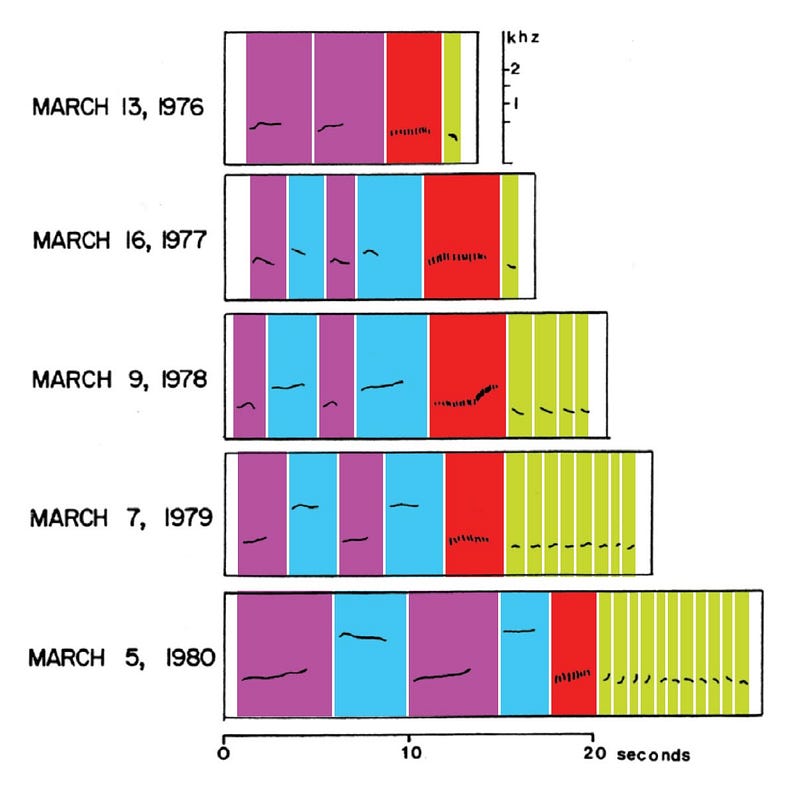
One theme over five years, collected by Katy Payne. Each of these hand-traced sonograms is an “averaged” combination of all the theme’s phrases recorded in each respective year.
We overlaid color to highlight the changing sequence, as purple and blue units become longer, and green units are added by the whales.
There are seven more themes in the song, and each has its own kind of change — including shifts in pitch, rhythm, and tempo.

One theme over five months, collected by Katy Payne
If we look at another theme from the same song, this time over a five-month period within one year, we see changes happening month to month.
Extraordinarily, while the whales in each population have distinctly different dialects of song, all the whales within a population change their song together synchronously. A population’s territory can span thousands of miles. This emergent synchronization means that a whale in Mexico and a whale in Hawaii may each sing a different song this week than they did last week, while still singing roughly the same song as the other whale this week. No other animal develops its music so rapidly and regularly, let alone doing it in sync.
Why the change? Ms. Payne explains in a lecture on May 19th, at the Cornell Lab of Ornithology in Ithaca,
“This seems to be an example of cultural evolution…culture because these animals were learning from each other and remembering what they were learning from each other.”
Payne quotes linguistics pioneer Edward Sapir to describe how this phenomenon occurs in language, as patterns of symbols evolve at a macro scale,
“Language moves down time in a current of its own making. It has a drift … Every word, every grammatical element, every locution, every sound and accent is a slowly changing configuration, molded by the invisible and impersonal drift that is the life of language.”
Payne continues by putting whale courtship in the context of changing human fashion,
There’s a psychological concept describing how fashion works in human beings, called “optimal mismatch”. It’s great if you make a change that’s just extreme enough so that everybody will follow you, but no good if it isn’t different enough. So the optimal mismatch to set a new trend is just in that range. I supposed that’s happening as whales listen to each others songs.
In this way, the change in whale music is both as ordered and apparently arbitrary as our own evolving arts, such as our constant need for a new hit song. Maybe the whales, like us, just get bored with yesterday’s tunes.
The public’s response to the humpback whale’s song is thought to be the tipping point that inspired a worldwide ban on commercial whaling, enacted by the International Whaling Commission in 1986. In recent years, however, this ban has been under increasing attack by the commission, some of whose members want to return to the commercial hunting and harvesting of whales. So the job of saving the whales is not done yet. We hope these visualizations amplify this underwater music to a new audience, and spread awareness of these great creatures.
David Rothenberg is a musician, composer, author and philosopher-naturalist who writes and performs on the relationship between humanity and nature.
Mike Deal is a graphic designer who makes interactive products and data visualizations.

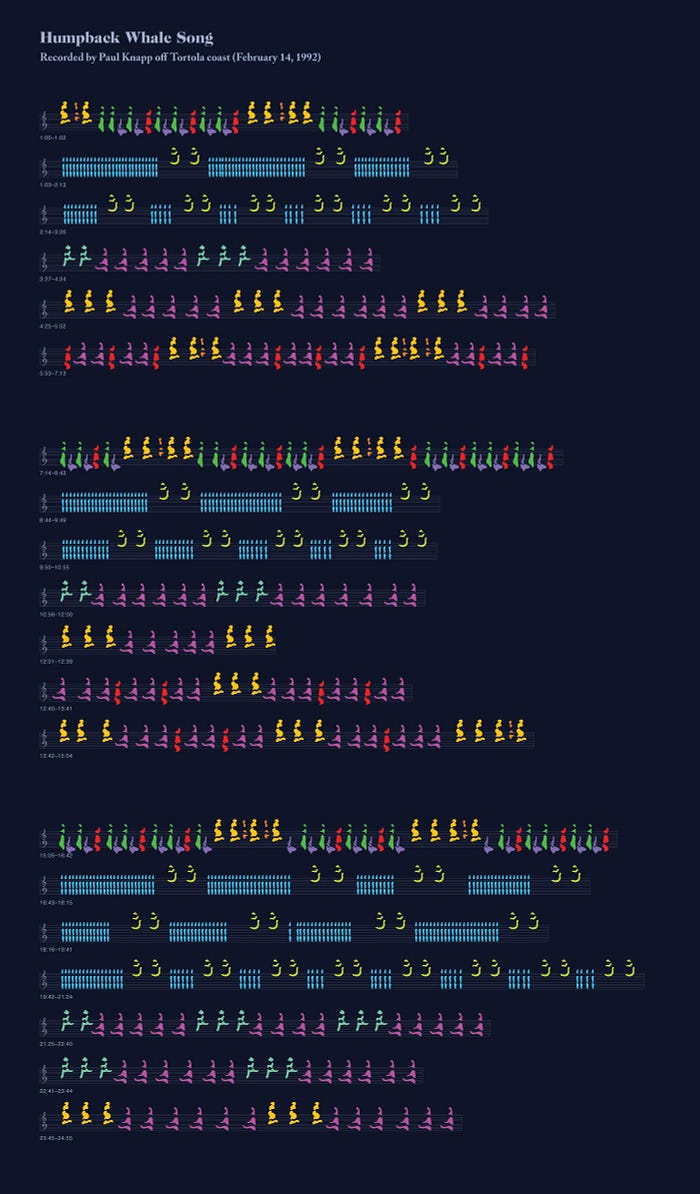
No comments:
Post a Comment